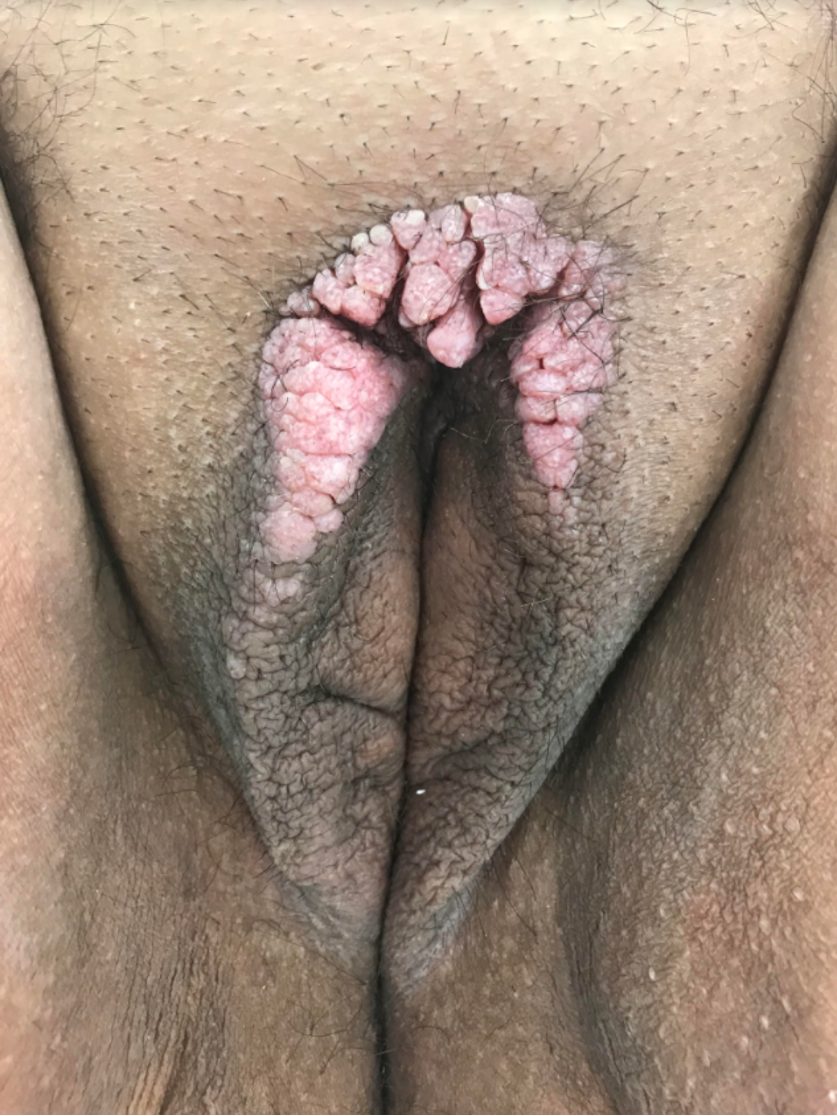Lymphangioma circumscriptum
Could you recognize this rare vulvar condition?
Presentation
A 38-year-old nulligravid woman has experienced worsening itchy and uncomfortable vulvar lesions over seven years. Initially, the lesions were small and scant. She was clinically diagnosed with genital warts, but various topical agents failed to stop the growth and spread of the lesions. She had never tested positive for HPV. Her medical history is significant for obesity, polycystic ovary syndrome, and asthma. Exam showed thick, rough, pink, and white warty projections along the mons and labia majora with mild underlying edema. The rest of the vulvar exam was normal.
Diagnosis
Lymphangioma circumscriptum (LC) or microcystic lymphatic malformation presents as clusters of pseudo-vesicles usually on the labia majora or mons pubis. The blisters contain serous or slightly-blood tinged fluid. In 1975, Moschelia et al. described the clinical presentation of this condition as one resembling “frog spawn.”1 LC can occur on the abdomen, axillae, genitalia, and mouth.2 In addition to the blistering, the vulva may be swollen and painful.3

The diagnosis of LC is made by biopsy. A Keyes punch biopsy should be sufficient. We recommend an accompanying photograph for your pathologist to review as well. On histology, LC shows dilated lymphatics in the epidermis and the papillary dermis. The dilated lymphatics contain red and white blood cells.4
When considering LC as a diagnosis, it is important to include infectious causes such as condylomata acuminata, molluscum contagiosum, and pelvic tuberculosis in your differential diagnoses. Similarly, lymphedema can manifest in patients with cutaneous Crohn disease and those with a history of pelvic cancers who have undergone surgery and pelvic radiation.
Discussion
LC is a benign lymphatic malformation characterized by dilation of lymphatic vessels in the skin and subcutaneous tissue. There are two types of disease: congenital and acquired. Congenital LC usually appears soon after birth, whereas the acquired version occurs later in life. Acquired LC is found more commonly on the vulvar region.4 The exact etiology of either type is unknown.
Interestingly, LC can be identified in patients with Klippel-Trenaunay syndrome (KTS). KTS is a relatively rare congenital vascular anomaly classically defined as the triad of vascular stain, venous varicosities, soft tissue, and/or bony hypertrophy. Many cases of KTS are mixed malformations with capillary, lymphatic, and venous elements.5
Management
Traditionally, the treatment of LC is surgical excision. We recommend 0.5 cm margins laterally around the disease. It is important to excise all of the tissue down to the fascia6 unless a skin graft is being performed. In this situation, a small amount of fat needs to remain for the skin graft to “take.” Often, a flap is required.
Therefore, collaboration with a plastic surgeon and/or referral for management in these situations may be needed. Other treatments that have been proposed are laser therapy, sclerotherapy, and cryosurgery.7 The recurrence rate is directly proportional to the original lesion size. Surgical excision has a lower risk of recurrence compared to other methods.7 However, due to the nature of LC, it will tend to recur if the original lesion is not fully excised.6,8
LC is not thought to have an isolated cancer risk but could be related to underlying cancer recurrence.9 However, Bae et al. identified a case series of 2 out of 16 patients with existing HPV-related cervical cancer who demonstrated new vulvar high-grade squamous intraepithelial neoplasia in vulvar LC.10 Appropriate evaluation with the patient’s oncologist should be considered in this setting.
Finally, patients may have some concerns about their personal appearance with this condition and any psychosocial concerns should be addressed.
__
References
1. Moschelia S. Dermatology. Philadelphia, PA: WB Saunders Company; 1975.
2. James W, Berger T, Elston D, eds. Dermal and Subcutaneous Tumors. In: Andrew’s Diseases of the Skin: Clinical Dermatology. 11th ed. Philadelphia, PA: Elsevier Inc; 2011:579.
3. Vlastos A, Malpica A, Follen M. Lymphangioma circumscriptum of the vulva: a review of the literature*1. Obstet Gynecol. 2003;101(5):946-954. doi:10.1016/s0029-7844(03)00048-6
4. Sinha A, Phukan JP, Jalan S, Pal S. Lymphangioma Circumscriptum of the Vulva: Report of a Rare Case. Journal of Mid-life Health 6, 91-93 (2015). http://10.0.16.7/0976-7800.158968.
5. Maari C, Frieden IJ. Klippel-Trénaunay syndrome: The importance of “geographic stains” in identifying lymphatic disease and risk of complications. J Am Acad Dermatol. 2004;51(3):391-398. doi:10.1016/j.jaad.2003.12.017
6. Haroon S, Hasan SH. Lymphangioma circumscriptum in the scrotum: A case report. J Med Case Rep. 2012;6. doi:10.1186/1752-1947-6-233
7. Lai CH, Hanson SG, Mallory SB. Lymphangioma circumscriptum treated with pulsed dye laser. Pediatr Dermatol. 2001;18(6):509-510. doi:10.1046/j.1525-1470.2001.1862001.x
8. Browse N, Whimster I, Stewart G, Helm C, Wood J. Surgical management of ‘lymphangioma circumscriptum’’.’ Br J Surg. 1986;73(7):585-588.
9. Valente K, Montgomery K, Schultenover S, Desouki MM. Acquired vulvar lymphangioma circumscriptum after cervical cancer treatment: Case report. Gynecol Oncol Rep. 2016;16:31-33. doi:10.1016/j.gore.2016.03.006
10. Bae G, Yoon G, Song Y, Kim H. High-grade squamous intraepithelial lesion arising adjacent to vulvar lymphangioma circumscriptum: a tertiary institutional experience. Oncotarget. 2016;7(30):48120-48129.

Current treatments for recurrent bacterial vaginosis leave many patients dissatisfied
February 28th 2025A new study presented at ISSWSH highlights patient dissatisfaction with current treatments for recurrent bacterial vaginosis, emphasizing the need for more effective therapies and improved provider communication.
Read More
Dequalinium chloride found noninferior to metronidazole for BV treatment
May 9th 2024Explore how dequalinium chloride stands as a promising alternative to metronidazole in treating bacterial vaginosis, offering comparable efficacy, safety, and tolerability, as revealed by a recent noninferiority trial.
Read More
